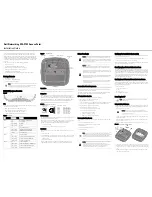
2
AP User Guide
February 2009
This symbol alerts the user to the presence of non-insulated dangerous voltage that
may be of sufficient magnitude to constitute a risk of lethal electric shock to persons.
This symbol alerts the user to important operating, maintenance, and servicing instruc-
tions. Failing to comply with instructions may result in electrical shock.
This symbol alerts the user to the presence of important operating, maintenance, and
servicing instructions. Failing to comply with this instruction may result in a hazard.
Do not open the cover
Dangerous voltages inside.
•
No serviceable parts inside.
•
Refer to qualified service personnel.
•
Unit has tamper-evident labeling that indicates when the cover has been removed.
•
Safety Instructions
Outdoor HotPoint APs must be installed by a qualified professional. Failure to install this equipment prop-
erly may result in equipment damage, personal injury, or death.
Explanation of Graphic Symbols
Caution! Risk of electric shock!
POWER LINES CAN BE LETHAL
Do not install Firetide products where possible contact with power lines can be made. Antennas,
poles, towers, guy wires, or cables may lean or fall and contact these lines. People may be injured
or killed if they are touching or holding any part of equipment when it contacts electric lines. Make
sure there is NO possibility that equipment or personnel can come in contact directly or indirectly
with power lines.
ASSUME ALL OVERHEAD LINES ARE POWER LINES
The horizontal distance from a tower, pole or antenna to the nearest power line should be at least
twice the total length of the pole/antenna combination. This will ensure that the pole will not
contact power if it falls either during or after installation.
SURVEY THE SITE
Look over the entire site before beginning any installation and anticipate possible hazards. Never
assume anything without checking it out for yourself! Don’t take shortcuts!
TO AVOID FALLING, USE SAFE PROCEDURES WHEN WORKING AT HEIGHTS ABOVE GROUND
Select equipment locations that will allow safe and simple installation.
•
Don’t work alone. A friend or co-worker can save your life if an accident happens.
•
Don’t attempt repair work when you are tired. Not only will you be more careless, but your primary diagnostic tool - deduc-
•
tive reasoning - will not be operating at full capacity.
Use approved non-conducting ladders, shoes, and other safety equipment. Make sure all equipment is in good repair.
•
If a tower or pole begins falling, don’t attempt to catch it. Stand back and let it fall.
•
If anything such as a wire or pole does come in contact with a power line, DON’T TOUCH IT OR ATTEMPT TO MOVE IT. In-
•
stead, save your life by calling the power company.
Don’t attempt to erect antennas or towers on windy days.
•
MAKE SURE ALL TOWERS AND POLES ARE SECURELY GROUNDED, AND ELECTRICAL CABLES CONNECTED TO ANTENNAS HAVE
•
LIGHTNING ARRESTORS. This will help prevent fire damage or human injury in case of lightning, static build-up, or short
circuit within equipment connected to the antenna. The HotPort outdoor node has built-in lightning protection. Be sure
that any other equipment connected to the HotPort node also has the same level of protection.
The base of the antenna pole or tower must be connected directly to the building protective ground or to one or more
•
approved grounding rods, using 10 AWG ground wire and corrosion-resistant connectors.
Refer to the National Electrical Code for grounding details.
•
IF AN ACCIDENT SHOULD OCCUR WITH THE POWER LINES
DON’T TOUCH THAT PERSON, OR YOU MAY BE ELECTROCUTED.
•
Use a non-conductive dry board, stick, or rope to push or drag them so they no longer are in contact with electrical
•
power.
Once they are no longer contacting electrical power, administer CPR if you are certified.
•
Immediately have someone call for medical help.
•



































